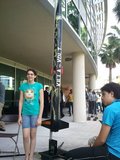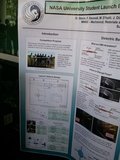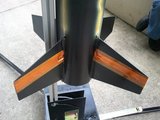
A week or so ago, I went to the UCF College of Engineering and Computer Science Annual Senior Design Symposium on Renewable and Sustainable Energy (say that ten times fast!). As it was held just before my daughter's birthday, I offered to take her with me. She was excited to go, and so we both played hooky for the day.
This wasn't the first time for either of us: I've attended all four years, and she went with me last year. We both enjoy talking with the engineers and looking at the projects, so we skipped the lectures this year and just checked out the presentations.
And took pictures!
There are too many pictures for a single post, so I'll split them up a little. (This has nothing whatsoever to do with me trying to provide more content for my webpage, no, not at all. What a crass suggestion.)
First up: a ten-foot tall plasma-guided rocket!

This team of aeronautical and mechanical engineers had picked a NASA competition for their project. They were required to build a rocket that would reach exactly 1 mile altitude carrying a scientific payload. They decided that they could get two birds with one stone by using their guidance system as their payload.
Most rockets control their path by spinning; the spin is controlled with gyroscopes and movable fins. This team kept the gyros, but used dielectric plasma deflectors to control the spin. They're like big exposed capacitors; when you send pulses of electricity through them, they either disrupt or enhance the airflow around the fin.
Our Heroes decided that disrupting the flow would probably provide a greater effect than enhancing it, disturbing the airflow around the fins so much that they wouldn't even have to move the fins at all. This video demonstrates the disruption (original raw video here):
And this video shows (briefly, and very dimly) the plasma (original raw video here):

Whenever you want roll, you just activate the strips on one side of each fin. The airflow on that side is disrupted, so you get lift on the other side. Et voila, roll!
There were three mechanical engineers and an aerospace engineer working on this project. Obviously building the electronics to drive the fin required an electrical engineer; one of the mechanical engineers hit the books (and the other resources) to work that part.
In part 2, we take a look at two farings for human-powered vehicles!